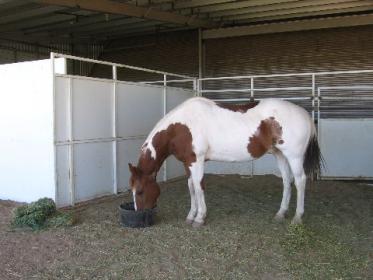Pinto patterns are very interesting. If the horse has just one pattern gene (ie, just tobiano, just overo, just splash), the patterns will be fairly predictable but the level of expression (the percent of colour to white) will not be. So if you have a tobiano with “maximum colour/minimum white” expression, the pattern will be similar (but never identical) to a tobiano with the same level of expression. And if you have a tobiano with 50/50 colour/white expression, the pattern will be recognizably the same as other tobianos with the same expression.
If the horse has genes for different patterns, such as tobiano + overo, or tobiano + splash, the patterns tend to get much wilder and more random. I think it is also more likely that you will get a white horse with blue eyes, or a “medicine hat” horse, which is white with pink skin, and only a spot of colour on the top of the head and ears.
http://www.cameopaints.net/horse-photo.php?id=13
A horse can carry a pinto gene with minimum expression, for instance an Overo with no pinto spots, just high socks and a big blaze. So before genetic testing, we didn’t really know necessarily the genetics behind various patterns.
BTW, Overo pattern apparently mutated in the Americas. There may be imported Overos in Europe now, but not historically. That is why the British don’t have a word to distinguish between Tobiano and Overo patterns. They call a black pinto a piebald, and other colours skewbald, but they are all Tobiano patterns.


